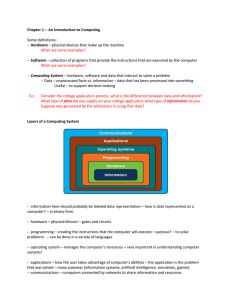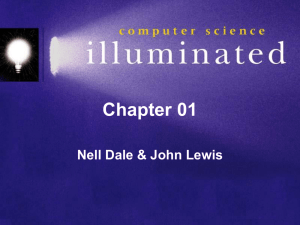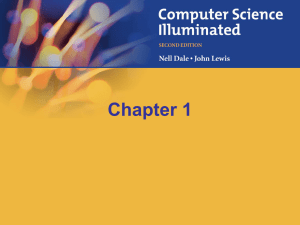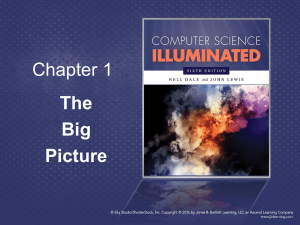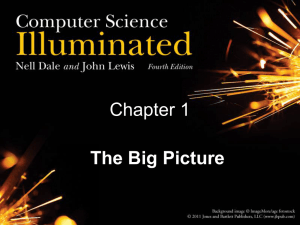chapter_16
advertisement
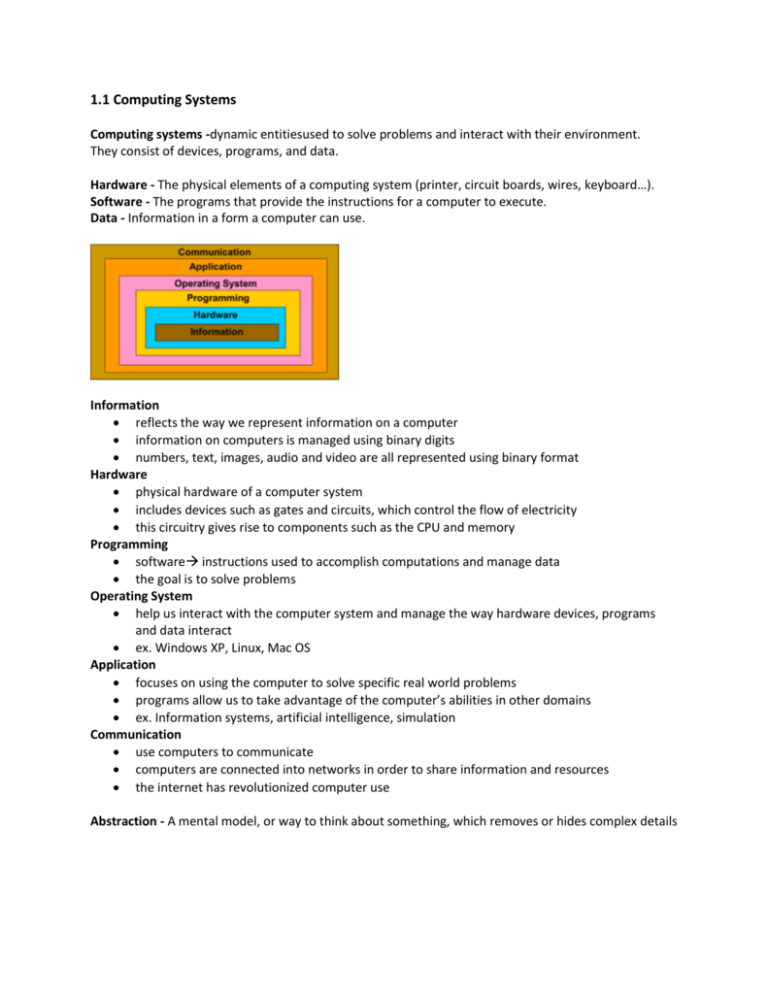
1.1 Computing Systems Computing systems -dynamic entitiesused to solve problems and interact with their environment. They consist of devices, programs, and data. Hardware - The physical elements of a computing system (printer, circuit boards, wires, keyboard…). Software - The programs that provide the instructions for a computer to execute. Data - Information in a form a computer can use. Information reflects the way we represent information on a computer information on computers is managed using binary digits numbers, text, images, audio and video are all represented using binary format Hardware physical hardware of a computer system includes devices such as gates and circuits, which control the flow of electricity this circuitry gives rise to components such as the CPU and memory Programming software instructions used to accomplish computations and manage data the goal is to solve problems Operating System help us interact with the computer system and manage the way hardware devices, programs and data interact ex. Windows XP, Linux, Mac OS Application focuses on using the computer to solve specific real world problems programs allow us to take advantage of the computer’s abilities in other domains ex. Information systems, artificial intelligence, simulation Communication use computers to communicate computers are connected into networks in order to share information and resources the internet has revolutionized computer use Abstraction - A mental model, or way to think about something, which removes or hides complex details 1.2 History of Computing Abacus (2400 BC) An early device to record numeric values. Blaise Pascal (1623-1662) Created a mechanical device to add and subtract Gottfried Wilhelm von Leibniz (1646-1716) Created a mechanical device to perform all four whole number operations. Joseph Jacquard Jacquard’s Loom (1801), the punched card Charles Babbage (1792-1871) Difference Engine, Analytical Engine Augusta Ada Byron (Lovelace) Babage’s assistant Considered to be the first Programmer, Invented the concept of the loop William Burroughs (1857-1898) Adding Machine Herman Hollerith (1860-1929) Electro-mechanical Tabulator Alan Turing (1912-1954) Turing Machine - an abstract mathematical model Artificial Intelligence Testing Early computers launch new era in mathematics, physics, engineering and economics: Harvard Mark I (1939) ENIAC - Electronic Numerical Integrator and Calculator EDVAC - Electronic Discrete Variable Automatic Computer o first machine with a stored program UNIVAC I - Universal Automatic Computer (1951) First Generation Hardware (1951-1959) Vacuum Tubes Large, not very reliable, generated a lot of heat Magnetic Drum Memory device that rotated under a read/write head Card Readers Magnetic Tape Drives Sequential auxiliary storage devices Second Generation Hardware (1959-1965) Transistor Replaced vacuum tube fast, small, durable, cheap Magnetic Cores Replaced magnetic drums information available instantly Magnetic Disks Replaced magnetic tape data can be accessed directly Third Generation Hardware (1965-1971) Integrated Circuits Replaced circuit boards smaller, cheaper, faster, more reliable Transistors Now used for memory construction Terminal An input/output device with a keyboard and screen Fourth Generation Hardware (1971-?) Large-scale Integration Great advances in chip technology PCs, the Commercial Market, Workstations Personal Computers were developed as new companies like Apple and Atari came into being Workstations emerged Moore’s Law restated in a different form “computers will either double in power at the same price or halve in cost for the same power every 18 months” Parallel Computing and Networking Parallel Computing Computers rely on interconnected central processing units that increase processing speed. Networking With the Ethernet small computers could be connected and share resources. A file server connected PCs in the late 1980s. ARPANET and LANs Internet First Generation Software (1951-1959) Machine Language Computer programs were written in binary (1s and 0s). Assembly Languages and translators Programs were written in artificial programming languages and were then translated into machine language. Programmer Changes Programmers divide into application programmers and systems programmers. Second Generation Software (1959-1965) High Level Languages English-like statements make programming easier. Fortran, COBOL, Lisp are examples. Application programmers Third Generation Software (1965-1971) Systems Software utility programs, language translators, and the operating system, which decides which programs to run and when. Separation between Users and Hardware Computer programmers began to write programs to be used by people who did not know how to program. Fourth Generation Software (1971-1989) Structured Programming Pascal, C, C++ New Application Software for Users spreadsheets word processors database management systems Fifth Generation Software (1990- present) Microsoft The Windows operating system, and other Microsoft application programs dominate the market. Object-Oriented Design Based on a hierarchy of data objects (i.e. Java). World Wide Web Allows easy global communication through the Internet. New Users Today’s user needs no computer knowledge. Computing as a Tool: Chapter 11 refer to class notes CSE_A_ch11
